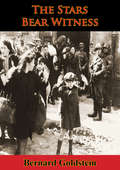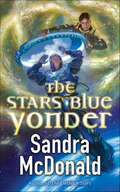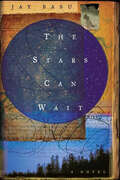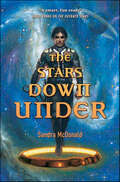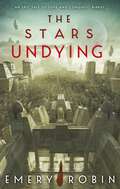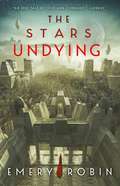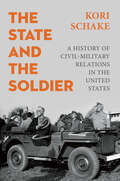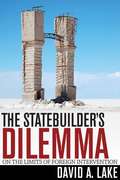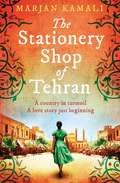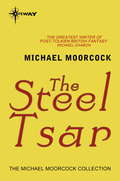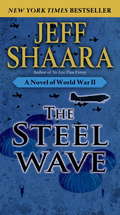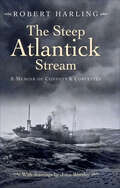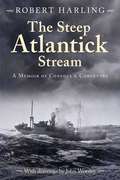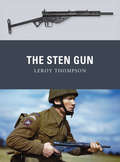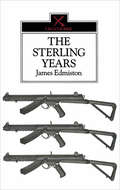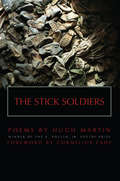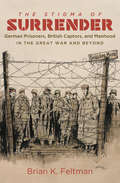- Table View
- List View
The Stars Bear Witness [Illustrated Edition]
by Bernard Goldstein Leonard ShatzkinIncludes 204 photos, plans and maps illustrating The Holocaust"Born in a small town outside of Warsaw in 1889, Bernard Goldstein joined the Jewish labor organization, the Bund, at age 16 and dedicated his life to organizing workers and resisting tyranny. Goldstein spent time in prisons from Warsaw to Siberia, took part in the Russian Revolution and was a respected organizer within the vibrant labor movement in independent Poland."In 1939, with the Nazi invasion of Poland and establishment of the Jewish Ghetto, Goldstein and the Bund went underground--organizing housing, food and clothing within the ghetto; communicating with the West for support; and developing a secret armed force. Smuggled out of the ghetto just before the Jewish militia's heroic last stand, Goldstein assisted in procuring guns to aid those within the ghetto's walls and aided in the fight to free Warsaw. After the liberation of Poland, Goldstein emigrated to America, where he penned this account of his five-and-a-half years within the Warsaw ghetto and his brave comrades who resisted to the end. His surprisingly modest and frank depiction of a community under siege at a time when the world chose not to intervene is enlightening, devastating and ultimately inspiring."-Print ed."His active leadership before the war and his position in the Jewish underground during it qualify him as the chronicler of the last hours of Warsaw's Jews. Out of the tortured memories of those five-and-a-half years, he has brought forth the picture with all its shadings--the good with the bad, the cowardly with the heroic, the disgraceful with the glorious. This is his valedictory, his final service to the Jews of Warsaw."--Leonard Shatzkin
The Stars Blue Yonder (The Outback Stars #3)
by Sandra McDonaldChief Terry Myell died and became a god. Now he's back to life, careening around space and time at the behest of a voice that told him to save all of mankind. Helping and hindering this quest are his elderly wife, his young wife, grandchildren who haven't been born yet, romantic rivals he hasn't even met, a descendant from two thousand years in the future, and an alien nemesis who calls itself the Flying Doctor. Life in the military has never been so complicated.Commander Jodenny Scott would agree. She's seven months pregnant and trying to come to peace with her husband's death. When Myell reappears with tales of time travel, she's not sure what to believe.But with an invading army bearing down on Earth's last fleet of spaceships, there's not much time for debate. When the dust clears Jodenny is stranded in an Australia she never imagined, and Myell's more desperate than ever to rescue her—from aliens, from treachery, and from history itself.At the Publisher's request, this title is being sold without Digital Rights Management Software (DRM) applied.
The Stars Can Wait: A Novel
by Jay BasuIn this powerful debut set in 1940s German-occupied Poland, a young Catholic boy unearths the secrets of his brother's mysterious life.Fifteen-year-old Gracian Sofka is a stargazer. Every night for the past year he has broken curfew to view the constellations from a clearing in the forest-that is, until his older brother, Pawel, discovers his secret pastime. And now that the German troops have stepped up patrols of the area, the gruff, mysterious Pawel forbids his brother to continue his risky activity. Life in the previously quiet village of Malenkowice grows increasingly precarious. Men are accosted on the street by German soldiers, Gracian's widowed mother risks imprisonment to smuggle food, and Gracian's co-workers at the coal mines grow restless. As tension builds in the town, it also grows within Gracian's own household. After a run-in with his sister's husband, Pawel is forced to leave the house, becoming even more distant and elusive in Gracian's eyes. Then one day Pawel presents Gracian with a telescope, allowing the boy to slowly discover the truth about his brother's shadowy past. But while he succeeds in unlocking Pawel's secrets, Gracian is blind to the inevitable tragedy hurtling toward them all-and to his unwitting role as its catalyst. Haunting and lyrical, Jay Basu's The Stars Can Wait possesses the intense, concentrated power of a fable and introduces a stunning new voice to American readers.
The Stars Down Under (The Outback Stars #2)
by Sandra McDonaldChief Terry Myell and Lieutenant Commander Jodenny Scott are in that most precarious of military situations, a mixed marriage. Enlisted and officer. It's unnatural. Terry and Jodenny have been assigned to duty on the planet Fortune, away from the huge ships that carry colonists from the wreckage of polluted Earth to clean new worlds across the galaxy. But there's another way besides spaceships to travel from world to world. A group within Team Space is exploring the Wondjina Spheres, a set of ancient alien artifacts that link places and times. Now those spheres have shut down and Team Space thinks that Terry and Jodenny are part of the key to make them work again —no matter how the two of them feel about it. They can volunteer, or be "volunteered." What the researchers can't anticipate is that the status quo, in which Team Space holds the monopoly on travel between worlds, is about to change. And as a result, Terry and Jodenny will be tested to their limits and beyond…. At the Publisher's request, this title is being sold without Digital Rights Management Software (DRM) applied.
The Stars Undying
by Emery RobinA spectacular space opera debut perfect for readers of Ann Leckie's Ancillary Justice and Arkady Martine's A Memory Called Empire, inspired by the lives and loves of Cleopatra and Julius Caesar.LOYALTY, LEGACY AND BETRAYAL...Princess Altagracia has lost everything. After a bloody civil war, her twin sister has claimed not just the crown of their planet Szayet but the Pearl of its prophecy, a computer that contains the immortal soul of their god. Stripped of her birthright, Altagracia prepares to flee the planet - just as Matheus Ceirran, Commander of the interstellar Empire of Ceiao, arrives in deadly pursuit. Princess Altagracia sees an opportunity to win back her planet, her god, and her throne . . . if she can win over the Commander and his distrustful right-hand officer, Anita.But talking her way into Commander Matheus's good graces, and his bed, is only the beginning. Dealing with the most powerful man in the galaxy is almost as dangerous as war, and Altagracia is quickly torn between Matheus and the wishes of the machine god that whispers in her ear. For Szayet's sake, and her own, Altagracia will need to become more than a princess with a silver tongue. She will have to become a queen as history has never seen before - even if it breaks an empire.'Dazzling, transportive, boundless, precise - and dares to ask, what if Mark Antony was the hottest butch girl in space?' Casey McQuiston'A glittering triumph that weaves together history and tragedy into a star-spanning epic. I fell into this book and didn't come out for a long time' Everina Maxwell'Gorgeously written, clever and captivating' Kristyn Merbeth'Takes the larger-than-life figures of the ancient world and recasts them against a backdrop of drowned worlds and interstellar empires with extraordinary verve' Emily Tesh'Deftly wields the conventions of science fiction to make old stories new... I did not know I could weep for Antony, love Cleopatra, or lament Caesar, but through Ana, Gracia, and Ceirran, I do' Maya Deane'Beautifully written, with poise and wit and grand epic sweep, The Stars Undying has everything I want from a space opera' AK Larkwood
The Stars Undying
by Emery RobinA spectacular space opera debut perfect for readers of Ann Leckie's Ancillary Justice and Arkady Martine's A Memory Called Empire, inspired by the lives and loves of Cleopatra and Julius Caesar.LOYALTY, LEGACY AND BETRAYAL...Princess Altagracia has lost everything. After a bloody civil war, her twin sister has claimed not just the crown of their planet Szayet but the Pearl of its prophecy, a computer that contains the immortal soul of their god. Stripped of her birthright, Altagracia prepares to flee the planet - just as Matheus Ceirran, Commander of the interstellar Empire of Ceiao, arrives in deadly pursuit. Princess Altagracia sees an opportunity to win back her planet, her god, and her throne . . . if she can win over the Commander and his distrustful right-hand officer, Anita.But talking her way into Commander Matheus's good graces, and his bed, is only the beginning. Dealing with the most powerful man in the galaxy is almost as dangerous as war, and Altagracia is quickly torn between Matheus and the wishes of the machine god that whispers in her ear. For Szayet's sake, and her own, Altagracia will need to become more than a princess with a silver tongue. She will have to become a queen as history has never seen before - even if it breaks an empire.'Dazzling, transportive, boundless, precise - and dares to ask, what if Mark Antony was the hottest butch girl in space?' Casey McQuiston'A glittering triumph that weaves together history and tragedy into a star-spanning epic. I fell into this book and didn't come out for a long time' Everina Maxwell'Gorgeously written, clever and captivating' Kristyn Merbeth'Takes the larger-than-life figures of the ancient world and recasts them against a backdrop of drowned worlds and interstellar empires with extraordinary verve' Emily Tesh'Deftly wields the conventions of science fiction to make old stories new... I did not know I could weep for Antony, love Cleopatra, or lament Caesar, but through Ana, Gracia, and Ceirran, I do' Maya Deane'Beautifully written, with poise and wit and grand epic sweep, The Stars Undying has everything I want from a space opera' AK Larkwood
The Stars Undying (Empire Without End #1)
by Emery RobinA "dazzling" tale of empire and betrayal set among the stars (#1 New York Times bestselling author Casey McQuiston), this queer, spectacular space opera draws inspiration from Roman and Egyptian empires—and the lives and loves of Cleopatra and Julius Caesar. Princess Altagracia has lost everything. After a bloody civil war, her twin sister has claimed both the crown of their planet, Szayet, and the Pearl of its prophecy: a computer that contains the immortal soul of Szayet&’s god. So when the interstellar Empire of Ceiao turns its conquering eye toward Szayet, Gracia sees an opportunity. To regain her planet, Gracia places herself in the hands of the empire and its dangerous commander, Matheus Ceirran. But winning over Matheus, to say nothing of his mercurial and compelling captain Anita, is no easy feat. And in trying to secure her planet&’s sovereignty and future, Gracia will find herself torn between Matheus&’s ambitions, Anita&’s unpredictable desires, and the demands of the Pearl that whispers in her ear. For Szayet&’s sake and her own, she will need to become more than a princess with a silver tongue. She will have to become a queen as history has never seen before."A glittering triumph of a book that weaves together history and tragedy into a star-spanning epic." —Everina Maxwell, author of Winter&’s Orbit
The Stars We Share: A Novel
by Rafe Posey&“Dazzles from start to finish.&” —Georgia Hunter, New York Times bestselling author of We Were the Lucky Ones Set against the backdrop of World War II, a sweeping, atmospheric novel of sacrifice, ambition, and commitment, and the secrets we keep from the ones we loveIt's 1927 when Alec and June meet as children in a tranquil English village. Alec, an orphan, anchors himself in the night sky and longs for adventures. June memorizes maps and railway timetables, imagining a future bright with possibilities. As the years pass, their loves feels inevitable, but soon the Second World War separates them. Alec enlists as a Royal Air Force pilot flying daredevil fighter sorties at night; June finds her calling as a codebreaker at Bletchley Park, covert work that will mean keeping her contribution to the war effort a secret from Alec forever. Each is following a dream—but those dreams force them apart for years at a time. Their postwar reunion is bittersweet: Alec, shot down and imprisoned in a series of POW camps, grapples with his injuries and the loss of his RAF career. June, on the other hand, has found her vocation and struggles to follow the expected path to domesticity, as much as she loves Alec. But Alec wants nothing more than to make a life and a family together. With the war behind them, their scars—both visible and unseen—make them strangers to each other. Now each must decide how much to reveal to the other, which dreams can be sacrificed, and which secrets are too big to bear alone. Spanning forty years and shifting from bustling Indian ports to vibrant gardens in Edinburgh to a horse farm in Kenya, The Stars We Share is a poignant, heart-wrenching novel about the decisions and concessions that make a life and a love worth having.
The Starship Trap (Star Trek: The Original Series #64)
by Mel GildenThe Starship Trap En route to an important diplomatic reception the U.S.S. Enterprise suddenly is set upon by a Klingon warship. The unprovoked assault, Kirk discovers, is in response to what the Klingon ship's captain claims are recent Federation attacks on several Klingon vessels which have disappeared. Managing to secure a truce, Captain Kirk reaches the reception only to find out it is not just Klingon ships that are disappearing, but Federation vessels, Romulan Birds of Prey, and ships from almost every known race are vanishing without a trace. Now, Captain Kirk and the crew of the Starship Enterprise must determine the fate of the missing ships before the entire known galaxy is drawn into a deadly conflict.
The State and the Soldier: A History of Civil-Military Relations in the United States
by Kori SchakeAmerica’s Founding Fathers feared that a standing army would be a permanent political danger, yet the U.S. military has in the 250 years since become a bulwark of democracy. Kori Schake explains why in this compelling history of civil-military relations from independence to the challenges of the present. The book begins with General Washington's vital foundational example of subordination to elected leaders during the Revolutionary War. Schake recounts numerous instances in the following century when charismatic military leaders tried to challenge political leaders and explains the emergence of restrictions on uses of the military for domestic law enforcement. She explores the crucial struggle between President Andrew Johnson and Congress after Lincoln’s assassination, when Ulysses Grant had to choose whether to obey the Commander-in-Chief or the law – and chose to obey the law. And she shows how the professionalization of the military in the twentieth century inculcated norms of civilian control. The U.S. military is historically anomalous for maintaining its strength and popularity while never becoming a threat to democracy. Schake concludes by asking if its admirable record can be sustained when the public is pulling the military into the political divisions of our time.
The Statebuilder's Dilemma: On the Limits of Foreign Intervention
by David A. LakeThe central task of all statebuilding is to create a state that is regarded as legitimate by the people over whom it exercises authority. This is a necessary condition for stable, effective governance. States sufficiently motivated to bear the costs of building a state in some distant land are likely to have interests in the future policies of that country, and will therefore seek to promote loyal leaders who are sympathetic to their interests and willing to implement their preferred policies. In The Statebuilder's Dilemma, David A. Lake addresses the key tradeoff between legitimacy and loyalty common to all international statebuilding attempts. Except in rare cases where the policy preferences of the statebuilder and the population of the country whose state is to be built coincide, as in the famous success cases of West Germany and Japan after 1945, promoting a leader who will remain loyal to the statebuilder undermines that leader's legitimacy at home. In Iraq, thrust into a statebuilding role it neither anticipated nor wanted, the United States eventually backed Nouri al-Malaki as the most favorable of a bad lot of alternative leaders. Malaki then used the support of the Bush administration to govern as a Shiite partisan, undermining the statebuilding effort and ultimately leading to the second failure of the Iraqi state in 2014. Ethiopia faced the same tradeoff in Somalia after the rise of a promising but irredentist government in 2006, invading to put its own puppet in power in Mogadishu. But the resulting government has not been able to build significant local support and legitimacy. Lake uses these cases to demonstrate that the greater the interests of the statebuilder in the target country, the more difficult it is to build a legitimate state that can survive on its own.
The Stationery Shop of Tehran
by Marjan KamaliPre-order THE LION WOMEN OF TEHRAN, a heartfelt, epic new novel of friendship, betrayal and redemption, coming November 2024.*** If you read The Little Coffee Shop of Kabul and enjoyed The Beekeeper of Aleppo, you will love The Stationery Shop of Tehran *** 1953, Tehran. In a small shop in a country on the brink of unrest, two people meet for the very first time. Roya loves nothing better than to while away the hours in the stationery shop run by Mr Fakhri. The store, stocked with fountain pens, shiny ink bottles, and thick wads of writing paper, also carries translations of literature from all over the world. Bahman, with his burning passion for justice, is like no one else she has ever met. But all around them, as their relationship blossoms, life in Tehran is changing. Suddenly, shockingly, violence erupts: a coup d'etat that forever changes their country's future, as well as their own.Marjan Kamali's beautiful novel explores themes of love and loss, and delivers and unforgettable ending. &‘An enchanting romance&’ MY WEEKLY &‘Simultaneously briskly paced and deeply moving, this will appeal to fans of Khaled Hosseini and should find a wide audience&’BOOKLIST &‘Evocative, devastating, and hauntingly beautiful… This book broke my heart again and again&’Whitney Scharer, author of THE AGE OF LIGHT &‘What a pleasure — a novel that is all at once masterfully plotted, beautifully written, and populated by characters who are arresting, lovable and so real&’Elinor Lipman, author of TURPENTINE LANE &‘A beautiful and sensitive novel that I loved from the first page&’Alyson Richman, international bestselling author of THE LOST WIFE &‘A beautifully immersive tale … brings to life a lost and complex world and the captivating characters who once called it home&’Jasmin Darznik, New York Times bestselling author of THE GOOD DAUGHTER and SONG OF A CAPTIVE BIRD &‘A sweeping romantic tale of thwarted love&’KIRKUS REVIEWS &‘The unfurling stories… will stun readers… For those who enjoy getting caught up in romance while discovering unfamiliar history of another country&’LIBRARY JOURNAL &‘Grab your tissues'BOSTON MAGAZINE &‘A tender story of enduring love.&’MINNEAPOLIS STAR TRIBUNE &‘I! Am! Obsessed! With! This! Book!&’COSMOPOLITAN.COM
The Stationery Shop of Tehran
by Marjan Kamali1953, Tehran. Roya loves nothing better than to while away the hours in the local stationery shop run by Mr. Fakhri. The store, stocked with fountain pens, shiny ink bottles, and thick pads of writing paper, also carries translations of literature from all over the world. And when Mr. Fakhri introduces her to his other favorite customer -- handsome Bahman, with his burning passion for justice and a shared love for Rumi's poetry -- Roya loses her heart at once. But around them, life in Tehran is changing. On the eve of their marriage, Roya heads to the town square to meet with Bahman. Suddenly, shockingly, violence erupts: a coup d'etat that forever changes their country's future. Bahman never arrives. Roya must piece her life back together. Her parents, wanting her to be safe, enroll her in college in California, where she meets and marries another man. But, nearly sixty years later, an accident of fate finally brings her the answer she has always wanted to know - Why did you leave? Where did you go? How is it that you were able to forget me?Marjan Kamali's beautiful novel, set in a country poised for democracy but destroyed by political upheaval, explores issues that have never been more timely, of immigration and cultural assimilation, of the quirks of fate. And its ending will break readers' hearts.
The Steel Seraglio
by Mike Carey Linda Carey Louise Carey&“A confident One Thousand and One Nights for our present . . . Furious pop entertainment—full of sex, passion, violence, and magic.&” —Slant magazine This is the story of the legendary City of Women, told through the tales of those who founded it, championed it, and made it flourish. When the city of Bessa undergoes a violent coup, its lazy, laissez-faire ruler, Bokhari Al-Bokhari, is replaced by the religious zealot Hakkim Mehdad. With little use for the pleasures of the flesh, Hakkim sends his predecessor&’s 365 concubines to a neighboring sultan as a gift. But when the new sultan discovers the concubines are harboring Al-Bokhari&’s youngest son—a child who might grow up to challenge his rule—he repents of his mercy and sends his soldiers to slaughter the seraglio down to the last woman and child. What he doesn&’t count on is a concubine trained in the art of murder—or the courage and fortitude of the women who will rise up with her to forge their own city out of the unforgiving desert. It&’s an undertaking beset with challenges: hunger and thirst, Hakkim&’s relentless hate, and the struggle to make a place for themselves in a world determined to underestimate and undermine them. Through a mosaic of voices and tales, we learn of the women&’s miraculous rise, their time of prosperity—and how they carried with them the seed of their own destruction. &“A thrilling tale.&” —Publishers Weekly &“A masterful, engaging and utterly fascinating story by three wonderful writers.&” —SFRevu.com &“The Steel Seraglio brings its alternate world of struggle, politics and magic very much to life.&” —Locus
The Steel Tsar
by Michael MoorcockIn his epic adventures in the alternative Twentieth Centuries, Chrononaut Oswald Bastable, member of the League of Temporal Adventurers, has crossed and re-crossed many different time-streams. Some of his previous experiences have been told in The Land Leviathan and The Warlord of the Air.Now, in what may be the last communication from him, he tells of a world in which the Bolshevik Revolution never happened...The Steel Tsar finds him travelling backwards in time from a shell-shocked Singapore to a Russian Empire seething with conflict and preyed on by motley bands of rogues and adventurers. Here he meets up with fellow-time-traveler Miss Una Persson, and together they change the course of a history whose legendary deeds exceed the bounds of everyday imagination and glitter in the exuberant land of the eternal present.
The Steel Wave: A Novel of World War II
by Jeff ShaaraBONUS: This edition contains an excerpt from Jeff Shaara's No Less Than Victory. Jeff Shaara, America’s premier author of military historical fiction, brings us the centerpiece of his epic trilogy of the Second World War. General Dwight Eisenhower once again commands a diverse army that must find its single purpose in the destruction of Hitler’s European fortress. His primary subordinates, Omar Bradley and Bernard Montgomery, must prove that this unique blend of Allied armies can successfully confront the might of Adolf Hitler’s forces, who have already conquered Western Europe. On the coast of France, German commander Erwin Rommel fortifies and prepares for the coming invasion, acutely aware that he must bring all his skills to bear on a fight his side must win. But Rommel’s greatest challenge is to strike the Allies on his front, while struggling behind the lines with the growing insanity of Adolf Hitler, who thwarts the strategies Rommel knows will succeed. Meanwhile, Sergeant Jesse Adams, a no-nonsense veteran of the 82nd Airborne, parachutes with his men behind German lines into a chaotic and desperate struggle. And as the invasion force surges toward the beaches of Normandy, Private Tom Thorne of the 29th Infantry Division faces the horrifying prospects of fighting his way ashore on a stretch of coast more heavily defended than the Allied commanders anticipate–Omaha Beach. From G.I. to general, this story carries the reader through the war’s most crucial juncture, the invasion that altered the flow of the war, and, ultimately, changed history.
The Steel Wave: A Novel of World War II #2
by Jeff ShaaraJeff Shaara, America's premier author of military historical fiction, brings us the centerpiece of his epic trilogy of the Second World War. General Dwight Eisenhower once again commands a diverse army that must find its single purpose in the destruction of Hitler's European fortress. His primary subordinates, Omar Bradley and Bernard Montgomery, must prove that this unique blend of Allied armies can successfully confront the might of Adolf Hitler's forces, who have already conquered Western Europe. On the coast of France, German commander Erwin Rommel fortifies and prepares for the coming invasion, acutely aware that he must bring all his skills to bear on a fight his side must win. But Rommel's greatest challenge is to strike the Allies on his front, while struggling behind the lines with the growing insanity of Adolf Hitler, who thwarts the strategies Rommel knows will succeed. Meanwhile, Sergeant Jesse Adams, a no-nonsense veteran of the 82nd Airborne, parachutes with his men behind German lines into a chaotic and desperate struggle. And as the invasion force surges toward the beaches of Normandy, Private Tom Thorne of the 29th Infantry Division faces the horrifying prospects of fighting his way ashore on a stretch of coast more heavily defended than the Allied commanders anticipate--Omaha Beach. From G.I. to general, this story carries the reader through the war's most crucial juncture, the invasion that altered the flow of the war, and, ultimately, changed history.
The Steep Atlantick Stream: A Memoir of Convoys & Corvettes
by Robert HarlingFirst published in 1946, this atmospheric memoir of the battle of the Atlantic offers one of the most original accounts of war at sea aboard a corvette, escorting convoys in both the North and South Atlantic. The author, an RNVR lieutenant, experienced the terrors of U-boat attacks and the hardships of autumn gales as well as the relief of shore runs in ports as far apart as Halifax and Freetown. The narrative begins with Harling’s voyage from the Clyde to New York on the Queen Mary (or QM, as she was known during her martial career), on route to join a newly-built corvette in Halifax, Nova Scotia. He was to be her First Lieutenant, and his service at sea started in the spring of 1941, just as the battle of the Atlantic was entering its most crucial stage. During the first east-bound convoy he was to experience attacks by U-boats, the loss of merchant vessels and a steep learning curve as the ship’s crew struggled to live in the harsh wartime conditions. Later that summer they made return voyages to Iceland where runs ashore offered some solace from dangerous days at sea. Time was also spent in the South Atlantic with voyages to Freetown and Lagos, before a short interlude when he experienced the excitement of fighting with Coastal Forces. The corvette subsequently returned to escorting convoys from Halifax to Europe. His narrative is both serious and humorous, and his picture of wartime Britain, his descriptions of being buffeted by great storm-tossed seas in the ‘cockleshell corvettes’, and the recounting of grim losses are all too real and authentic. His story ends as he leaves his ship after a violent cold developed into pneumonia, and soon afterwards he hears the heart-breaking news of her loss, along with the captain and half the crew, after being torpedoed. He is left to ponder on the many tombless dead consigned by the war to the Steep Atlantick Stream.
The Steep Atlantick Stream: A Memoir of Convoys and Corvettes
by Robert HarlingFirst published in 1946, this atmospheric memoir of the Battle of the Atlantic offers one of the most original accounts of war at sea aboard a corvette, escorting convoys in both the North and South Atlantic. The author, an RNVR lieutenant, experienced the terrors of U-boat attacks and the hardships of icy gale-force winds contrasted with the relief of shore runs in ports as far apart as Halifax and Freetown.The narrative begins with Harling&’s voyage from the Clyde to New York on the Queen Mary (or QM, as she was known during her martial career), on route to join a newly-built corvette in Halifax, Nova Scotia. He was to be her First Lieutenant, and his service at sea started in the spring of 1941, just as the Battle of the Atlantic was entering its most crucial stage. During the first east-bound convoy he was to experience attacks by U-boats, the loss of merchant vessels and a steep learning curve as the ship&’s crew struggled to live in the harsh wartime conditions. Later that summer they made return voyages to Iceland where runs ashore offered some solace from dangerous days at sea. Time was also spent in the South Atlantic with voyages to Freetown and Lagos, before a short interlude when he experienced the excitement of fighting with Coastal Forces. The corvette subsequently returned to escorting convoys from Halifax to Europe.Harling&’s narrative is both serious and humorous, and his picture of wartime Britain, his descriptions of being buffeted by great storm-tossed seas in the &‘cockleshell corvettes&’, and the recounting of grim losses are all too real and authentic. His story ends as he leaves his ship after a violent cold developed into pneumonia, and soon afterwards he hears the shattering news of her loss by torpedo, along with the captain and half the crew. He is left to ponder on the many tombless dead consigned by the war to the Steep Atlantick Stream.
The Sten Gun
by Leroy ThompsonThe Sten submachine gun - officially the 'Carbine, Machine, Sten' - was developed to fulfil the pressing British need for large quantities of cheaply produced weapons after Dunkirk, when German invasion was a very real possibility. Over four million were built during World War II, and the Sten was widely used by airborne troops, tankers, and others who needed a compact weapon with substantial firepower. It proved especially popular with Resistance fighters as it was easy to conceal, deadly at close range, and could fire captured German ammunition. Using stamped-metal parts that required minimal welding, the Sten's design was so simple that Resistance fighters were able to produce them in bicycle shops.The Sten influenced the development of other inexpensive, easy-to-produce submachine guns, such as the Australian Austen and the US M3 'Grease Gun', while copies of the Sten were produced in Argentina, France, Norway, Denmark, Poland, and even Nazi Germany. In the years after World War II, the Sten was used in Korea and in counterinsurgency campaigns in Malaya and Kenya. During the 1948 Palestine War, locally produced Stens were employed by Israeli forces; in 1984 Indira Gandhi was assassinated by one of her Sikh bodyguards using a Sten.Its postwar successor in British service, the Sterling, owed much to the Sten; early examples saw combat at Arnhem in 1944 and it remained in service as late as 1988. Suppressed versions of the Sterling were used by British, Australian and New Zealand SAS forces, and the weapon even saw action with US Special Forces troops until the early days of the Vietnam War.Featuring vivid first-hand accounts, specially commissioned full-colour artwork and close-up photographs, this is the fascinating story of the mass-produced submachine gun that provided Allied soldiers and Resistance fighters with devastating close-range firepower.
The Stepney Doorstep Society: The remarkable true story of the women who ruled the East End through war and peace
by Kate ThompsonThe unsung and remarkable stories of the women who held London's East End together during not one, but two world wars. 'Inspiring tales of courage in the face of hardship' Mail on Sunday'Inspiring . . . Takes you back to a time of community and helping one another' 5***** Reader Review'It made me laugh and gasp in equal measure' 5***** Reader Review______ Meet Minksy, Gladys, Beatty, Joan and Girl Walker . . . While the men were at war, these women ruled the streets of the East End. Struggling against poverty to survive, and fighting for their community in our country's darkest hours. But there was also joy to be found. Across the East End the streets were alive - you need only walk a few steps for a smile from a neighbour or a strong cup of tea. From taking over the London Underground, standing up to the Kray twins and crawling out of bombsites, The Stepney Doorstep Society tells the vivid and moving stories of the matriarchs who remain the backbone of the East End to this day. ______ 'Kate Thompson's study of five working-class women who lived through the blitz shows how informal collectives can provide lasting support and inspiration . . . [a] fascinating account' Guardian 'An important glimpse into a vanishing world' Sunday Express'One of the best books I have read in recent years' 5***** Reader Review 'Crammed full of fascinating stories' BBC 2 Steve Wright'Fascinating . . . It was fascinating to hear how these women kept going' 5***** Reader Review 'Astonishing' Radio 5 Live
The Sterling Years: Small Arms and the Men
by James EdmistonThis is the story of the manufacture, development and usage of one of the most famous submachine Guns ever produced by a British Firm Designed at the end of WW2 it saw limited use on a trial basis, carried by paratroopers during the battle of Arnhem, but since the British Forces had plenty of Sten guns at the time, and tests between the two types of weapon were inconclusive, it was not until 1953, that with a few adjustments, the Weapon was formally adopted by the British Army Whilst not the most accurate of weapons, it was extremely useful in urban warfare and regarded as one of the most reliable submachine Guns throughout the world until it was withdrawn in 1988. A total of over 400,000 were manufactured. Sterling built them for the British armed forces and for overseas sales. The Sterling Guns was used as the basis for the weapons used by Storm Troopers in the Star Wars films.
The Stick Soldiers
by Hugh Martin Cornelius EadyAt age nineteen, Hugh Martin withdrew from college for deployment to Iraq. After training at Fort Bragg, Martin spent 2004 in Iraq as the driver of his platoon sergeant's Humvee. He participated in hundreds of missions including raids, conducting foot patrols, clearing routes for IEDs, disposing of unexploded ordnance, and searching thousands of Iraqi vehicles. These poems recount his time in basic training, his preparation for Iraq, his experience withdrawing from school, and ultimately, the final journey to Iraq and back home to Ohio.Hugh Martin holds an MFA from Arizona State University. He is a Stegner Fellow at Stanford University.
The Stick Soldiers (New Poets of America #35)
by Hugh MartinAt age nineteen, Hugh Martin withdrew from college for deployment to Iraq. After training at Fort Bragg, Martin spent 2004 in Iraq as the driver of his platoon sergeant's Humvee. He participated in hundreds of missions including raids, conducting foot patrols, clearing routes for IEDs, disposing of unexploded ordnance, and searching thousands of Iraqi vehicles. These poems recount his time in basic training, his preparation for Iraq, his experience withdrawing from school, and ultimately, the final journey to Iraq and back home to Ohio.Hugh Martin holds an MFA from Arizona State University. He is a Stegner Fellow at Stanford University.
The Stigma of Surrender: German Prisoners, British Captors, and Manhood in the Great War and Beyond
by Brian K. FeltmanApproximately 9 million soldiers fell into enemy hands from 1914 to 1918, but historians have only recently begun to recognize the prisoner of war's significance to the history of the Great War. Examining the experiences of the approximately 130,000 German prisoners held in the United Kingdom during World War I, historian Brian K. Feltman brings wartime captivity back into focus. Many German men of the Great War defined themselves and their manhood through their defense of the homeland. They often looked down on captured soldiers as potential deserters or cowards--and when they themselves fell into enemy hands, they were forced to cope with the stigma of surrender. This book examines the legacies of surrender and shows that the desire to repair their image as honorable men led many former prisoners toward an alliance with Hitler and Nazism after 1933. By drawing attention to the shame of captivity, this book does more than merely deepen our understanding of German soldiers' time in British hands. It illustrates the ways that popular notions of manhood affected soldiers' experience of captivity, and it sheds new light on perceptions of what it means to be a man at war.
